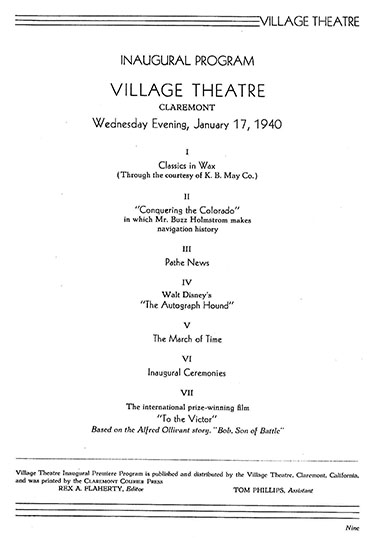The Village Theatre–Part 3

by John Neiuber
On Friday, January 12, 1940, the Claremont COURIER published an article about the work surrounding the opening of the theatre. The paper reported that “feverish activity was in progress at the new $35,000 Village Theatre at Third and Harvard this week.” Workmen were completing painting and the installation of theater chairs and putting on the finishing touches. The article stated that “Once seated in the highly comfortable red leather seats, spectators will find themselves in the first stadium type moving picture theater in the Southland, chiefly characterized by perfect visibility from any part of the auditorium.” The lobby featured a mural by Millard Sheets.
The theatre also ran an ad in the COURIER announcing the grand opening and listed its phone number as 5061. The seats for the premiere were 40 cents. Thereafter, prices would be 30 cents, loges 40 cents, children 10 cents and students 25 cents. Future performances would be a single feature, twice nightly at 7 and 9, with matinees Wednesdays, Saturdays and Sundays at 2:30. The ad also listed two short quotes about the feature film, To The Victor, from New York Times critic and author, Albert Payson Terhune and one from Yale University professor and author, William Lyon Phelps.
On Wednesday evening, January 17, over 500 people filled the theatre to capacity. Theatre goers were met at the front door by Stanley Larson, master of ceremonies. Larson had a microphone and recorded remarks by various attendees which were later played back to the audience. Lela Ackerman, secretary of the chamber of commerce, distributed copies of the souvenir program. Attendees were impressed with Richard Bare’s “booking ballot” concept.
The inaugural program began with the playing of recordings entitled, Classics in Wax presented by the K.B. May Co. K.B. May was located at 110 Harvard Avenue, currently the home of Square I Gallery. May advertised the store as the “largest record stock east of Los Angeles.” The record store featured labels such as Victor, Columbia, Bluebird, Vocalion and Decca.
The short film, Conquering the Colorado, was shown. The film documents the journey of Buzz Holstrom, the first person to navigate alone, in a homemade boat, the 1,100 miles of the Colorado River, from Green River Lakes to the Boulder Dam. The 10-minute film can still be seen today on YouTube.
Next came Pathe News, which was a United Kingdom and American producer of newsreels and documentaries from 1910 to 1970. Founder Charles Pathe was a pioneer of moving pictures in the silent film era in France, where Pathe News began. The Pathe News archive is known today as British Pathe and its collection of newsreels and movies is digitized and available online. The American company was separated from the British company in 1921 and sold to RKO Radio Pictures. Archived newsreels are available on YouTube.
The program also featured a six-and-one-half minute cartoon from Walt Disney, The Autograph Hound, featuring Donald Duck. The film features Donald Duck as an autograph hound attempting to get autographs from many stars of the day, all animated of course. This is also available on YouTube.
The second newsreel of the evening was The March of Time, produced jointly by Life Magazine and Time, Inc. and was shown in movie theatres from 1935 to 1951. It was based on a news documentary and dramatization series under the same name that was broadcast on CBS Radio in 1931. The March of Time was a monthly series of short feature films, typically twice the length of standard newsreels. The editors of Time called it “pictorial journalism.” The installments included reporting, on-location shots and dramatic reenactments. Selected newsreels are available on YouTube.
Following the newsreel came the inaugural ceremonies. Richard Larson introduced Mayor Homer E. Robbins, Lloyd Brehaut, president of the chamber of commerce, Robert Bernard, representing the colleges, Jim Jefferson, Pomona College student body president, and Virginia Waldo, Scripps College student body president. All extended their congratulations to A.L Reeves, owner and Richard Bare, manager. Following the presentations the lobby interviews were played.
The final installment of the evening was the feature film, To the Victor. A British film, it was released in England under the name, Owd Bob. The film was based on Bob, Son of Battle by Alfred Ollivant. It is about Cumbrian shepherds and their sheepdogs and tells the story of two rivals who compete to win the sheepdog’s cup. The film starred Will Fyffe, a celebrated English actor of the day.
The Friday, January 19 edition of the COURIER ran a feature article on the opening, “Theater Opens With Brilliant Inaugural Event,” accompanied by a pictorial essay, “Gala Opening Night at Village Theater in Pictures,” featuring nine photographs from the evening by COURIER photographer, Donald Ryrie, who was credited with adding to the “atmosphere of the premiere by reason of his ubiquitous flash bulbs.”
The COURIER reported that work on the theater had only concluded just minutes prior to the opening. Craftsmen were laying carpet and upholstering a bench beneath the Millard Sheets mural. When the “first performance audience streamed from the auditorium, they were greeted in the lobby and outside by another crowd eagerly waiting to be admitted for the second performance.”
The theatre was already advertising its upcoming offerings for Friday and Saturday, Wuthering Heights, starring Laurence Olivier and Merle Oberson. On Sunday and Monday, it would feature Spencer Tracy in Stanley and Livingston and on Tuesday, Wednesday and Thursday, Storm In A Teacup, starring Vivien Leigh.
Clearly, the Village Theatre was ahead of its time. Its arthouse approach, advanced technology, single showings and “booking ballot” were cutting edge. The theatre made a go of it for a while, but eventually it could not sustain itself financially and was sold to Fox West Coast Theatres. The theatre closed in 1979. Today we are fortunate that it has been adaptively reused for new purposes, allowing us to enjoy its history and architecture and contributing to the Village atmosphere.











0 Comments